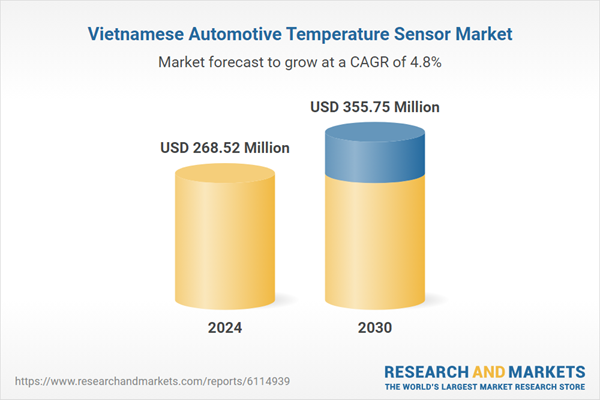Speak directly to the analyst to clarify any post sales queries you may have.
10% Free customizationThis report comes with 10% free customization, enabling you to add data that meets your specific business needs.
Key Market Drivers
Growth in Electric Vehicle (EV) Manufacturing and Adoption
The Vietnamese government's push toward greener mobility is accelerating the adoption of electric vehicles, which in turn fuels the demand for advanced temperature sensors. EVs require multiple high-precision sensors to monitor battery packs, electric motors, power electronics, and cabin temperatures. Local automaker VinFast is a major catalyst, with its aggressive EV expansion strategy that includes both domestic rollout and global exports.As per the Vietnam Automobile Manufacturers’ Association (VAMA), EV registrations surged over 45% year-on-year in 2024, and are expected to exceed 150,000 units by 2030, which directly corresponds to a heightened demand for IC, MEMS, and infrared temperature sensors. Battery management systems (BMS) in EVs are highly reliant on temperature sensors for safety and performance. This makes temperature sensors not just a functional component, but a critical safety and energy-efficiency enabler.
Key Market Challenges
High Dependence on Imported Sensor Technologies
Vietnam's domestic automotive sensor manufacturing capacity remains limited. Most advanced temperature sensors, particularly MEMS and IC-based designs, are imported from countries like Japan, South Korea, and Germany. This leads to higher production costs, import tariffs, and longer supply chains. The lack of in-house design and fabrication infrastructure for automotive-grade sensors creates vulnerability to global supply disruptions. For instance, the global semiconductor shortage of 2021-2023 impacted Vietnamese vehicle production significantly due to the scarcity of temperature and pressure sensors. Without strong domestic players or joint ventures in sensor R&D and production, Vietnam may face challenges in keeping up with future demand and innovations.Key Market Trends
Integration of Temperature Sensors in Battery Thermal Management Systems (BTMS)
One of the most significant trends is the increasing use of temperature sensors in battery thermal management for EVs and hybrids. Lithium-ion batteries are highly temperature-sensitive and require precise thermal regulation to maintain performance, longevity, and safety. Automotive OEMs in Vietnam, especially VinFast, are integrating up to 8-12 thermal sensors per vehicle to monitor battery cells, modules, and packs. These sensors enable dynamic heating and cooling based on real-time data, improving charging efficiency and battery lifespan. As the country moves toward battery swapping and high-speed charging, BTMS will play an even more critical role, driving the demand for high-accuracy sensors such as RTDs and thermistors.Key Market Players
- Robert Bosch GmbH
- Continental AG
- DENSO Corporation
- Sensata Technologies, Inc.
- TE Connectivity Ltd.
- NXP Semiconductors N.V.
- STMicroelectronics N.V.
- Texas Instruments Incorporated
- Analog Devices, Inc.
- HELLA GmbH & Co. KGaA
Report Scope:
In this report, the Vietnam Automotive Temperature Sensor market has been segmented into the following categories, in addition to the industry trends which have also been detailed below:Vietnam Automotive Temperature Sensor Market, By Vehicle Type:
- Passenger Cars
- Commercial Vehicles
Vietnam Automotive Temperature Sensor Market, By Product:
- Resistance Temperature Detectors (RTD)
- Thermistor
- MEMS
- IC Temperature Sensor
- Thermocouple
- Infrared Temperature Sensor
Vietnam Automotive Temperature Sensor Market, By Usage:
- Gas
- Air
- Liquid
Vietnam Automotive Temperature Sensor Market, By Application:
- Engine
- Exhaust
- HVAC
- Transmission
- Thermal Seats
- EV Battery
- EV Motor
Vietnam Automotive Temperature Sensor Market, By Technology:
- Contact
- Non-Contact
Vietnam Automotive Temperature Sensor Market, By Region:
- North Vietnam
- South Vietnam
- Central Vietnam
Competitive Landscape
Company Profiles: Detailed analysis of the major companies present in the Vietnam Automotive Temperature Sensor market.Available Customizations:
With the given market data, the publisher offers customizations according to a company's specific needs. The following customization options are available for the report.Company Information
- Detailed analysis and profiling of additional market players (up to five).
This product will be delivered within 1-3 business days.
Table of Contents
Companies Mentioned
- Robert Bosch GmbH
- Continental AG
- DENSO Corporation
- Sensata Technologies, Inc.
- TE Connectivity Ltd.
- NXP Semiconductors N.V.
- STMicroelectronics N.V.
- Texas Instruments Incorporated
- Analog Devices, Inc.
- HELLA GmbH & Co. KGaA
Table Information
| Report Attribute | Details |
|---|---|
| No. of Pages | 70 |
| Published | July 2025 |
| Forecast Period | 2024 - 2030 |
| Estimated Market Value ( USD | $ 268.52 Million |
| Forecasted Market Value ( USD | $ 355.75 Million |
| Compound Annual Growth Rate | 4.8% |
| Regions Covered | Vietnam |
| No. of Companies Mentioned | 10 |









